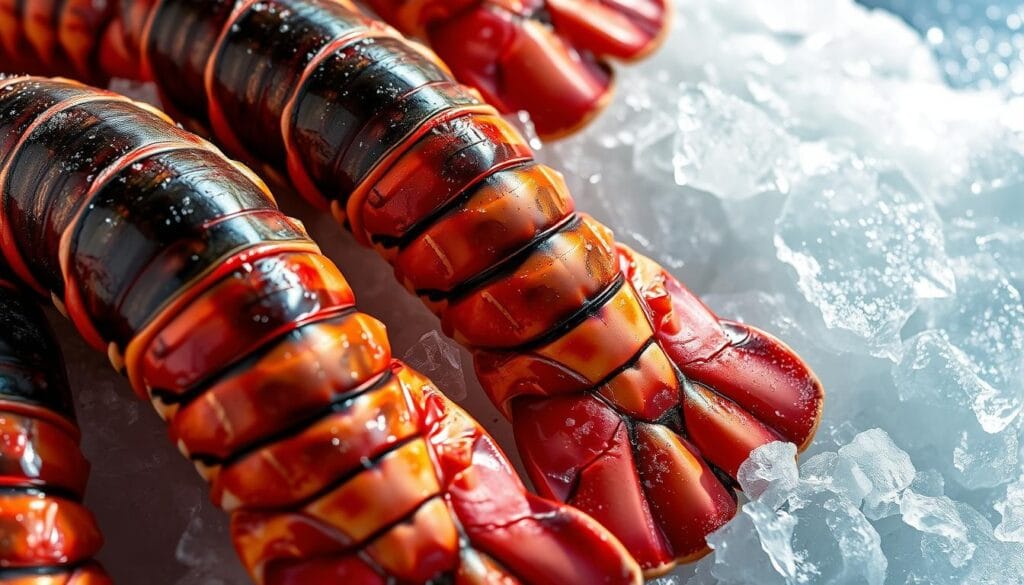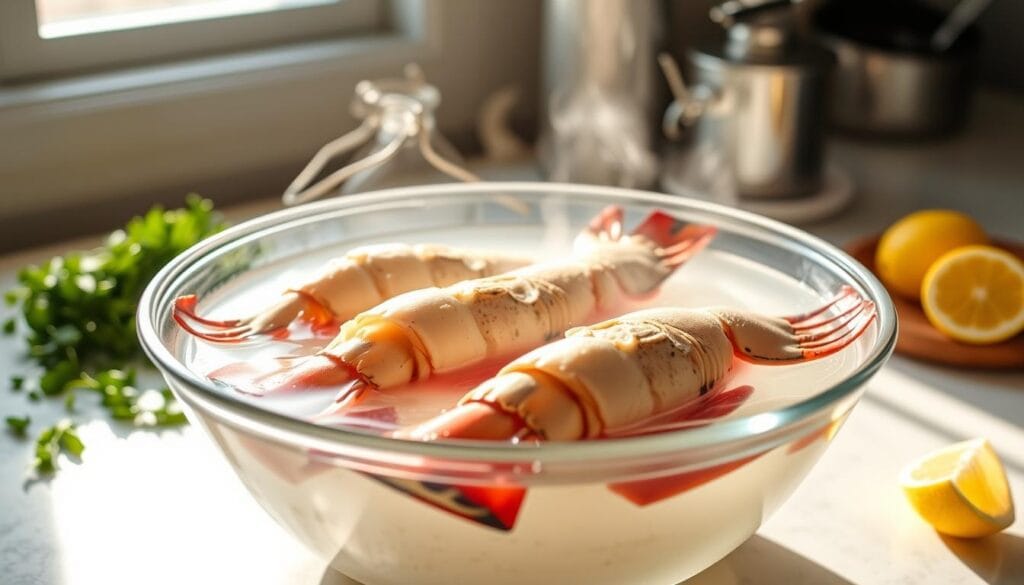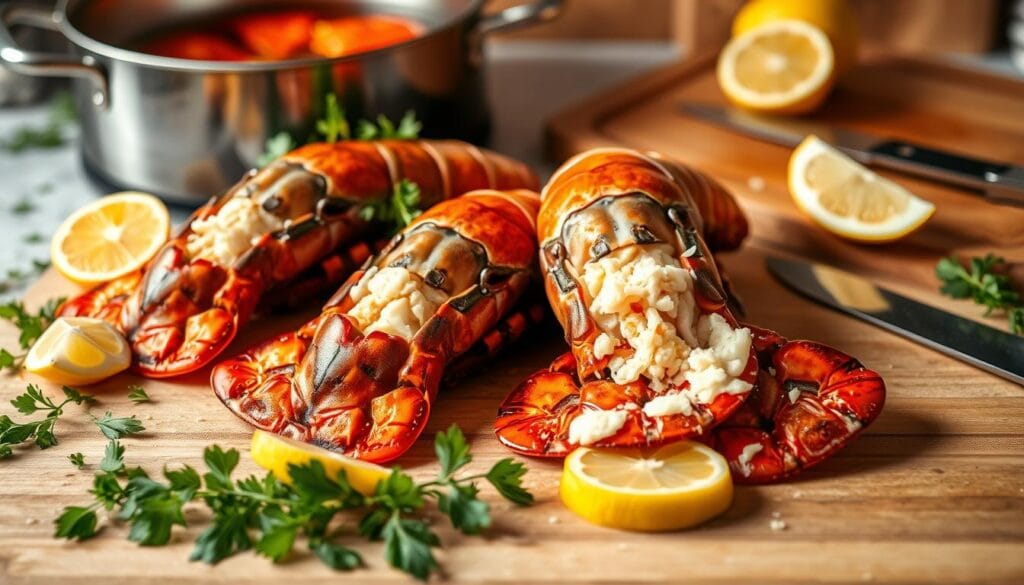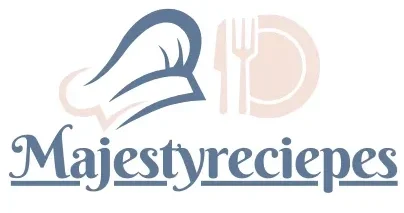Cooking frozen lobster tails is simpler than you might think once they thaw. Thawing is key for tender, sweet lobster meat. The right thawing and preparation are essential for the best results.
Table of contents
To start cooking frozen lobster tails, initially understand the thawing process. Accordingly, you can thaw them in the fridge or under cold running water. Then, after thawing, explicitly use different cooking methods to achieve the best taste.
Key Takeaways
- Firstly, cooking frozen lobster tails requires proper thawing for succulent and tender meat.
- Additionally, thawing can be done in the refrigerator or in cold running water.
- Moreover, frozen lobster tails are a great option for various recipes.
- Specifically, proper lobster tail preparation is essential for the best results.
- Lastly, the best way to cook frozen lobster tails involves thawing and cooking with flavorful sauces and seasonings.
- However, avoid overcooking to prevent lobster tails from becoming chewy or rubbery.
Understanding Frozen Lobster Tails
Frozen lobster tails are a tasty and easy way to enjoy lobster at home. There are two main types: cold water and warm water. Cold water tails are sweeter and more delicate, while warm water tails are firmer and have a stronger taste.
To get the best lobster tail quality, look for tails frozen quickly after catching. They should have a good color and texture. When storing frozen lobster tails, keep them at 0°F (-18°C) or below to avoid freezer burn. They can stay good for up to three months before freezer burn becomes a problem.
Here are some key facts to consider when buying and storing frozen lobster tails:
- Cold water lobster tails are generally considered to be of higher quality
- Warm water lobster tails are often less expensive and have great flavor and texture
- Frozen lobster tails should be stored at 0°F (-18°C) or below to prevent freezer burn
For more tips on selecting high-quality frozen ingredients, check out the ultimate guide to frozen lobster recipes.

Understanding the different types of lobster tails and how to ensure lobster tail quality helps you make better choices. This way, you can enjoy delicious lobster at home every time.
| Type of Lobster Tail | Flavor and Texture | Storage Life |
|---|---|---|
| Cold Water | Sweeter, more delicate flavor and succulent meat | Up to 3 months |
| Warm Water | Firmer texture and more robust flavor | Up to 3 months |
Preparing Your Frozen Lobster Tails
Certainly, thawing lobster tails is key when preparing them for cooking. Accordingly, the safest method involves thawing in the fridge, which takes several hours. Specifically, place the tails on a sheet pan in the fridge overnight for even thawing and to prevent bacterial growth.
Alternatively, for a quicker thaw, you can use cold water. However, be quick to avoid waterlogging. Undoubtedly, proper thawing techniques are vital for a great lobster dish.
Here are some tips for preparing lobster for cooking:
- Chiefly, thaw lobster tails in the refrigerator overnight for even cooking.
- Otherwise, thaw under cold water for a few minutes to speed up the process.
- Nevertheless, avoid letting lobster tails sit in water for too long to prevent waterlogging.

After thawing, you can cook lobster tails in many ways. Boiling, steaming, or pan-searing are all good options. Make sure they reach 140-145°F (60-63°C) for safety. With the right thawing and cooking, you’ll enjoy tasty lobster tails.
| Thawing Method | Time | Benefits |
|---|---|---|
| Refrigerator | Overnight | Even thawing, prevents bacterial growth |
| Cold Water | 30-60 minutes | Quick thawing, convenient |
The Best Way to Cook Frozen Lobster Tails
Cooking thawed lobster tails needs care, but the right methods make it easy. First, thaw them in the fridge overnight or in cold water for 20-30 minutes. Then, you’re ready to cook.
Poaching is a great way to cook lobster tails. It lets you add lots of flavors. Just put the tails in simmering water and cook until they hit 135°F or 140°F for extra firmness. Adding lobster tail seasoning can make it even tastier.
Butterflying Technique
Butterflying your lobster tail makes it look great and taste better. Cut it down the middle but don’t cut all the way through. This works with broiling, grilling, or poaching.
Seasoning Options
Seasoning lobster tails is fun with so many choices. Mix salted butter, garlic, lemon, smoked paprika, and cayenne for a tasty dish. Or, try different lobster tail seasoning blends to find your favorite.

Temperature Guidelines
Certainly, it’s important to cook lobster tails to the right temperature. Specifically, they should reach 135°F or 140°F for a firmer texture. Accordingly, a food thermometer ensures you avoid overcooking.
With these tips, you can undoubtedly prepare a delicious lobster dish. Whether you poach, broil, or grill, the secret lies in cooking with care. Explicitly, the right lobster tail seasoning and method will always impress your guests.
| Cooking Method | Temperature | Cooking Time |
|---|---|---|
| Poaching | 135°F – 140°F | 8-10 minutes |
| Broiling | 140°F | 1 minute per ounce |
| Grilling | 135°F – 140°F | 8-10 minutes |
Different Cooking Methods
Cooking frozen lobster tails offers several options, each with its own benefits and challenges. Popular methods include steaming, boiling, grilling, and broiling. For example, steamed lobster tails cook quickly, while boiled lobster tails take a bit longer.
Here are some key considerations for each cooking method:
- Steaming: 6-12 minutes, depending on size
- Boiling: 1 minute per ounce of tail weight
- Grilling: 30 minutes or less, with herb butter seasoning
- Broiling: 5-10 minutes, with high heat
When cooking grilled lobster tails or broiled lobster tails, watch the temperature and time closely. This helps avoid overcooking. By following these tips, you can enjoy tender and delicious lobster tails at home.
Cooking Techniques
Understanding different cooking techniques is key to great results. For instance, steamed lobster tails are tender and flavorful. On the other hand, boiled lobster tails can be tricky to cook evenly.
Tips and Variations
Some general tips apply to all cooking methods. Always thaw frozen lobster tails as instructed and pat them dry before cooking. Adding lemon juice, garlic, or other seasonings can also enhance the flavor of your steamed lobster tails, boiled lobster tails, grilled lobster tails, or broiled lobster tails.
Essential Tools and Ingredients
Certainly, to cook frozen lobster tails, you’ll need some basic tools and ingredients. Specifically, kitchen shears for butterflying, a skewer, and a skillet or wide saucepan for poaching are essential. Comparatively, you might already have these items, making it easier to start.
For lobster tail ingredients, you’ll need butter, garlic, and herbs. Accordingly, these add flavor to your dish. Here are the essential items:
- Firstly, kitchen shears
- Secondly, a skewer
- Thirdly, a straight-sided skillet or wide saucepan
- Additionally, butter
- Furthermore, garlic
- Lastly, herbs, such as parsley or thyme
Undoubtedly, having these tools and ingredients simplifies cooking frozen lobster tails. However, always handle and store your lobster tails safely for food quality.
| Tool/Ingredient | Description |
|---|---|
| Kitchen shears | For butterflying lobster tails |
| Skewer | For holding lobster tails in place |
| Straight-sided skillet or wide saucepan | For poaching lobster tails |
Pairing lobster tails with sides like fresh salads or seasoned vegetables can create a perfect meal. You can find pairing ideas in the comprehensive guide to baking with cottage cheese, which offers versatile recipes for complementary dishes.
Mistakes to Avoid for Perfectly Cooked Frozen Lobster Tails
When cooking frozen lobster tails, it’s key to steer clear of common mistakes. These can ruin the texture and flavor of the meat. Overcooking is a big mistake that makes the lobster chewy and rubbery.
Overcooking Issues
To avoid overcooking, keep an eye on the cooking time and temperature. Remember, undercooking can make the lobster fleshy and gelatinous. It can also be risky for your health.
Seasoning Errors
Seasoning mistakes can also mess up the lobster’s taste. Too much salt or strong seasonings can overpower the lobster’s delicate flavor. It’s better to use light seasoning and let the lobster’s natural taste come through.
Temperature Mistakes
Temperature errors can happen during cooking and serving. It’s vital to cook the lobster at the right temperature and serve it right away. This way, you can enjoy a perfectly cooked lobster that’s both tasty and safe.
Some common mistakes to avoid when cooking lobster include:
- Overcooking the lobster
- Underseasoning or overseasoning the lobster
- Not monitoring the temperature during cooking
To ensure a perfectly cooked lobster, it’s important to know these common mistakes. By following these tips, you can enjoy a delicious and safe lobster dish.
| Mistake | Effect | Prevention |
|---|---|---|
| Overcooking | Chewy and rubbery texture | Monitor cooking time and temperature |
| Undercooking | Fleshy, gelatinous consistency and possible foodborne illness | Cook to recommended internal temperature |
| Seasoning errors | Overpowering flavor | Use light seasoning and let natural flavor shine through |
Serving Suggestions and Pairings for Cooking Frozen Lobster Tails
Certainly, choosing the right side dishes and drinks enhances lobster tails. Specifically, drawn butter remains a classic choice. Accordingly, prepare it by slowly melting butter and removing the clear part. This method creates a simple yet tasty side.
For wine pairings, try Chardonnay, Sauvignon Blanc, or Pinot Grigio. Additionally, these dry and light wines perfectly complement lobster’s rich taste. Other great options include:
- Chiefly, sparkling wines like Champagne or Prosecco
- Similarly, light-bodied red wines like Pinot Noir or Gamay
- Furthermore, dry white wines with mineral undertones, such as Chenin Blanc
For plating ideas, add fresh lemon, garlic butter, and thoughtful presentation. Explicitly, garnish with fresh herbs or paprika for an appealing look.some presentation. Use fresh herbs or paprika to make it look good. Here’s a simple table to help plan:
| Side Dish | Wine Pairing | Plating Idea |
|---|---|---|
| Drawn Butter | Chardonnay | Fresh Lemon and Herbs |
| Garlic Mashed Potatoes | Sauvignon Blanc | Paprika and Chives |
Conclusion
Cooking frozen lobster tails is an art that can make your meals as good as a restaurant’s. By following the steps in this guide, you’ll get better at mastering lobster tail cooking. You’ll also make lobster tail recipe success that will wow your loved ones.
It’s important to be careful and detailed when cooking lobster tails. Try different ways of cooking and flavors. This will help you get better at making this tasty seafood dish.
So, put on your chef’s hat and start cooking. Whether you’re grilling or baking, you’ll have a great time. The results will be delicious. Bon appétit!
Cooking Frozen Lobster Tails: Common FAQs Answered
What are the different types of frozen lobster tails?
Certainly, frozen lobster tails come from cold water or warm water lobsters. Additionally, each type has its own taste and texture.
How can I identify high-quality frozen lobster tails?
Undoubtedly, high-quality lobster tails appear bright in color and feel firm to the touch. Moreover, they should be well-packaged to stay fresh.
What is the proper way to store frozen lobster tails?
Specifically, store frozen lobster tails in the freezer at a steady temperature. Consequently, this keeps them fresh and high quality.
What is the best method for thawing frozen lobster tails?
Explicitly, thawing in the fridge remains the safest and most even way to thaw frozen lobster tails.
Why is poaching the best cooking method for frozen lobster tails?
Generally, poaching makes lobster tails tender and flavorful. Comparatively, it’s better than steaming, boiling, grilling, or broiling.
What are the essential tools and ingredients needed for cooking frozen lobster tails?
Chiefly, you’ll need kitchen shears and a thermometer. Furthermore, butter, garlic, and herbs add flavor.
What are the common mistakes to avoid when cooking frozen lobster tails?
Notably, avoid overcooking and seasoning mistakes. Likewise, monitor the temperature to preserve the lobster’s texture and taste.
What are some classic accompaniments and wine pairings for cooked lobster tails?
Specifically, serve with drawn butter and lemon wedges. Additionally, choose crisp whites or light reds, depending on your taste and budget.

